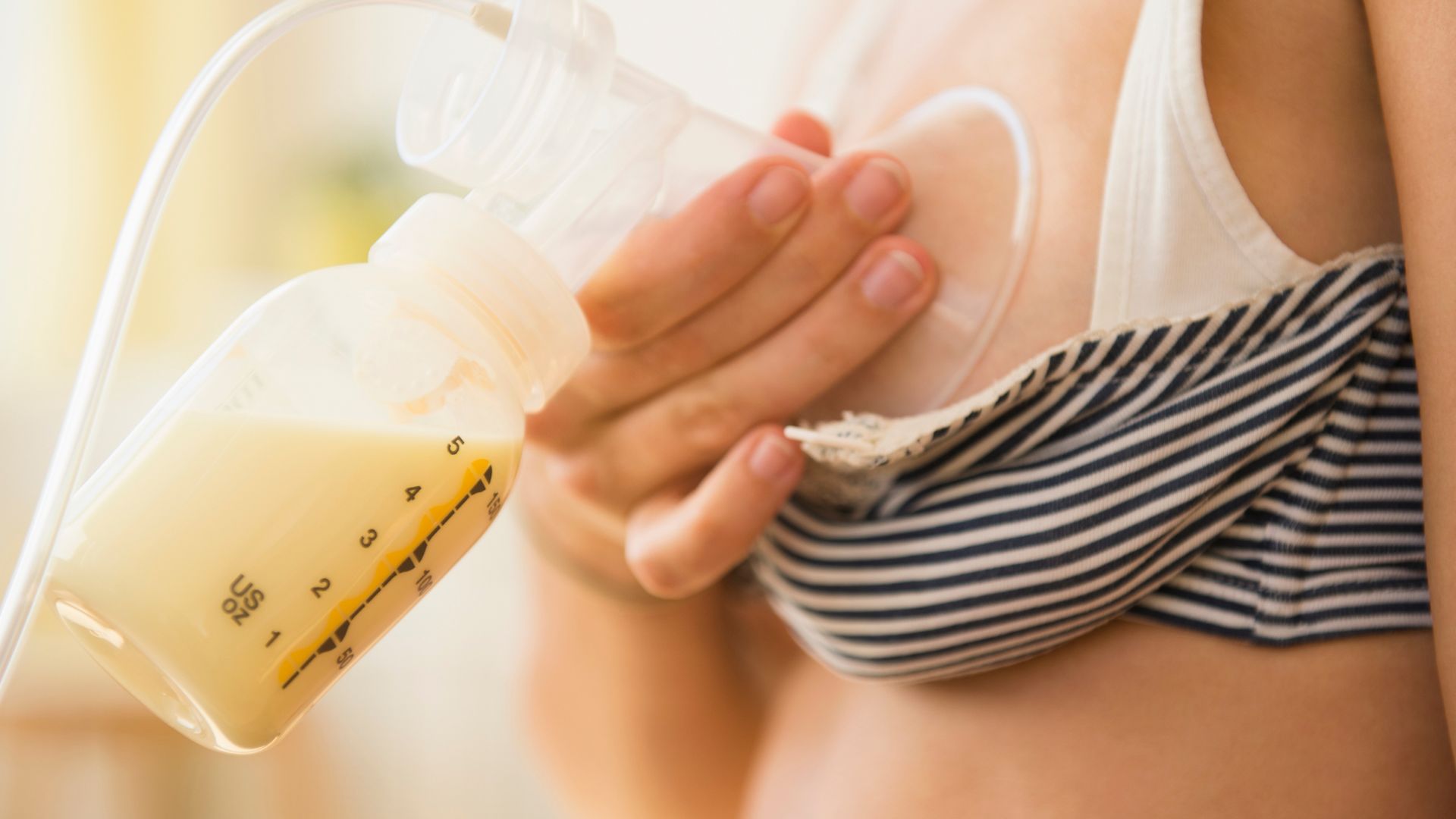How to increase milk supply - the 7 expert-approved ways and the top two myths busted
How to increase milk supply is a genuine concern among many new mums

Lesley Bland
How to increase milk supply is a worry that affects many new mums when they're in the early days of breastfeeding.
Whether just learning how to breast feed or getting to grips with a breast pump, every breastfeeding mom is aware of their milk flow and keen to see that it's increased and doing it's job for their new baby. There are many signs that your baby is getting enough breast milk, including seeing and hearing them swallowing, their cheeks staying rounded as they suck, coming off the breast on their own at the end of a feed, and seeming relaxed and content when they're done.
Myexpertwife.com, midwife Lesley Bland tells us; "When it comes to breastfeeding, two key hormones are at play; Oxytocin acts as the ‘waiter’ delivering the food but Prolactin is the ‘chef’ preparing food in the back kitchen."
Babies who are feeding well will typically gain weight after the first two weeks (during which time losing some of their birth weight is normal), and appear happy, healthy and satisfied. If you're concerned that you're not producing enough breast milk, or that your baby is not feeding properly, it's important to consult your midwife or health visitor - but there are some natural ways you can attempt to increase your breast milk supply as well.
Here are seven expert-approved tips on how to increase your milk supply
- Skin-to-skin contact
- Pumping and hand expressing
- Feed on-demand and don't skip or withhold feeds
- Don't skip late-night or early morning feeds
- Introduce Galactagogues
- Feeding as often and and as long as baby wants
- Check baby's latch and position
How to increase milk supply
Skin-to-skin contact – Myexpertmidwife.com midwife, Lesley Bland tells us "Skin-on-skin is an amazing and important start after birth which includes many benefits for both mum and baby. Not only does skin-to-skin transfer mum’s skin flora and microbiome to baby which helps strengthen and support their immune system, but skin-to-skin contact can also increase milk supply. There are two important milk-making hormones that are produced when you are in skin-to-skin with your baby, Prolactin and Oxytocin, which are responsible for breastmilk production and help the “let-down reflex” to release the milk. Remove all baby’s clothing including hats and mittens whenever possible to increase their skin’s contact with your own, which helps to facilitate bonding and increase hormone production.
Removing mittens allows baby to push and knead the breast which can help increase milk production and flow and guide them to the nipple. Removing hats reduces the risk of baby overheating during breastfeeding when they are absorbing your body heat and also lets mum smell their baby which can also increase the hormone oxytocin which helps increase breastmilk supply and flow. Recent research has shown that babies wearing hats during feeds showed reduced feed-seeking behaviours.
GoodtoKnow Newsletter
Parenting advice, hot topics, best buys and family finance tips delivered straight to your inbox.
Pumping and Hand Expressing – In the early days following the birth of your baby learning how to hand express can really help to increase your breast milk supply, especially if baby is slow to establish feeding. Learning how to massage the milk ducts sends signals that mimic your baby asking for milk. Remember it’s a supply/demand process and the more milk is demanded the more it will be supplied!

Pumping either with a manual, wearable, or electronic model is an effective and efficient way to stimulate your breasts to produce more milk and is ideal for moving on from hand expressing when producing larger volumes of milk. Pumping every couple of hours may be recommended by your healthcare provider when building up a supply but it is important not to over-stimulate your breasts to avoid engorgement. Most women find they express the highest volumes in the first few minutes of pumping so pumping for shorter periods of time more frequently may be preferable to longer less frequent episodes.
Feed on-demand and don’t skip or withhold feeds. Breasts left too full for too long will down-regulate milk production automatically through a polypeptide present in the milk which causes messages to be sent to the cells that control milk production. When breasts are regularly transferring milk to the baby the message says to ‘fill’ again after feeding, but if women stretch out the length of time between feeds a ‘feedback inhibitor of lactation’ kicks in to reduce milk production, hence the advice not to delay feeds.
Don’t skip the late-night or early-morning feeds. When it comes to breastfeeding, two key hormones are at play; Oxytocin acts as the ‘waiter’ delivering the food but Prolactin is the ‘chef’ preparing food in the back kitchen. Prolactin is important in milk production and peaks between 2am and 5am – so night feeds and early morning feeds are really important for guaranteeing long term-milk production – it is always good to ensure at least one night feed or pumping session takes place during this time.
Introduce Galactagogues - are foods and medications that have demonstrated increased breastmilk production. Research into Galactagogues is limited and any decision to introduce them for diagnosed low milk supply should be made with a healthcare provider and used in conjunction with other methods to increase the supply such as hand expressing, pumping, and skin-to-skin.
Some foods classed as galactagogues:
- Whole grains, especially oatmeal
- Dark, leafy greens (alfalfa, kale, spinach, broccoli)
- Fennel
- Garlic
- Chickpeas
- Ginger
- Papaya

Medications which may be prescribed in extreme cases of low milk supply such as Domperidone should be taken as per the instructions and it is rarely prescribed for more than 1 week. It would be recommended that medication is used alongside other methods of increasing lactation.
Feeding as often and for as long as your baby wants. This can help to increase your supply of breastmilk. Breasts work on a supply/demand basis so let baby lead the way and feed as often as they want, rather than to a schedule. Many healthcare providers will advise feeding baby 2-3 hourly but as long as baby has at least 8-12 feeds in a 24-hour period it doesn’t matter if they want to cluster feed or feed more frequently. Observe baby for signs of hunger and offer feeds when they are first interested, rather than allowing them to become distressed to help achieve an effective latch.
Check baby’s latch and position – think CHIN.
C – Close. Keep baby held close during a feed so they can take enough breast tissue into their mouth
H – Head. Leave baby’s head free so they can tilt their head to be able to achieve an optimal latch
I – In line. Your baby’s head and body need to be kept in a nice straight line so that they can feel comfortable whilst feeding
N – Nose to nipple. By placing baby’s nose to mum’s nipple, they will tilt their (free) head backwards so that the nipple can flip towards the back of their mouth towards the soft palate to help attachment.
How to increase milk supply - the two biggest myths
Myth: Separate mum and baby when not feeding to allow mum to rest and therefore increase her milk supply. Lesley tells us "We know that keeping mums and babies close especially when establishing breastfeeding in the first few weeks is important for helping and maintaining a good breastmilk supply. Separation is sometimes unavoidable for example if mum or baby requires specialist medical care following birth and during these times a plan should be put in place to support mum to increase her breastmilk supply. This could include regular updates for mum on her baby from the NNU and being able to see her baby when separated via photos and videos to encourage bonding and breastmilk production. Any expressed milk can then be given directly to the baby or can be stored in the fridge or freezer for use later."
Myth: Do not allow baby to breastfeed more frequently than 3-4 hourly so that the breasts can relax and build up their milk stores. Lesley says "Increased frequency of feeding stimulates the breast tissue to produce more milk and conversely feeding less frequently can reduce volumes produced, therefore resting the breasts is not conducive to increasing your milk supply."
How to increase milk supply - what the moms say
Ben and Jerry's Oat of This Swirled
Hey, who wouldn't want an excuse to eat extra ice cream? According to parenting site Romper, this particular tub of Ben and Jerry's has been dubbed something of a hero for breastfeeding mums.
The key ingredient in this brown sugar and cinnamon flavoured blend is oats, which the site explains 'contain saponins, which along with many other benefits, are thought to increase the milk making hormones lactating moms produce.' Of course, ice cream alone is unlikely to be the complete answer to how to increase breast milk, but if we're honest, we wouldn't hate eating a bowlful to give it a go...
Starbucks Pink Drink
Users on the Facebook page Milky Mamas brought this magical drink to public attention when one user said she's produced so much milk after consuming them that she'd leaked through to her T-shirt.
The beverage is a blend of a mixture of coconut milk and Starbucks' Strawberry Acai Refreshers, and the women of Milky Mamas aren't the only women who are convinced. Mum Stephanie Lester told Lifehacker that on her second day of drinking the Pink Drink, 'milk was literally spraying for almost a minute and that has never happened before'.
Lactation cookies
Figuring out how to increase breast milk can be tricky, but with lactation cookies on your side, at least it can also be tasty! Many mums swear by these biscuits, made with milk-boosting ingredients such as oats, coconut oil or nut butters, for giving them a breastfeeding boost.
Recipes vary, and it's worth playing around and finding one that suits your tastes. There are also some online companies who are supply ready-made lactation cookies, if you're not a dab hand in the kitchen.
Fenugreek
Fenugreek has long been a traditional remedy that is thought to increase breast milk supplies - and although research has debated its true effectiveness, it certainly won't hurt to give it a try.
Fenugreek supplements are available, but you can also enjoy it in a range of recipes, or even brewed as a tea. Other aromatic ingredients such as fennel, cumin and sesame are also believed to be beneficial for breastfeeding mothers.
Garlic milk
Okay, so this probably doesn't sound like your dream tipple, but garlic milk is another drink that's said to assist with lactation. Methods typically involve grating cloves of the stuff into water and milk, sweetening with honey or sugar to taste, and then boiling and straining.
Not sure you can face garlic in liquid form? Eating it may also be effective - one study, for instance, showed that babies of mums who ate garlic fed for longer than those who didn't.
However, other parents have reported that eating too much can lead to a colicky baby, so it's up to you (and your little one!) to decide if it's a helpful solution in your circumstances.
Related features:
Video of the Week:
Stephanie has been a journalist since 2008, she is a true dynamo in the world of women's lifestyle and family content. From child development and psychology to delicious recipes, interior inspiration, and fun-packed kids' activities, she covers it all with flair. Whether it's the emotional journey of matrescence, the mental juggling act of being the default parent, or breaking the cycle of parenting patterns, Stephanie knows it inside out backed by her studies in child psychology. Stephanie lives in Kent with her husband and son, Ted. Just keeping on top of school emails/fundraisers/non-uniform days/packed lunches is her second full-time job.
- Lesley BlandMidwife